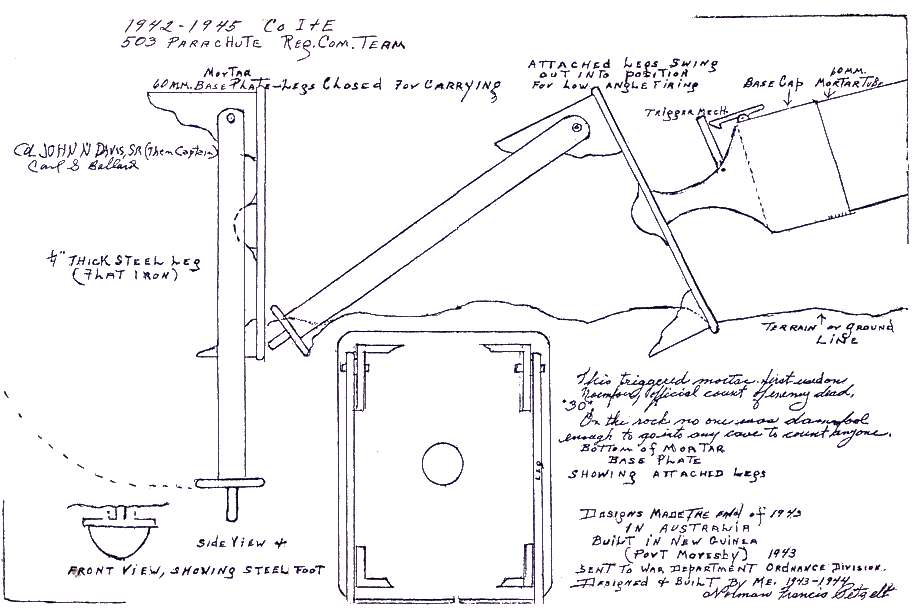|
|
 |
|
"PETZELT'S LOW-TRAJECTORY
MORTAR"
|
One of the more curious but practical weapons of the SWPA was the 60mm Petzelt Low Trajectory Mortar. The light weight and quick set-up of the M2 60mm mortar made it an excellent indirect fire support for fast moving and lightly armed Paratroopers. Its weakness in jungle terrain soon became evident to the mortar platoons training in northern Queensland. In areas where there was limited visibility due to tree cover, and particularly where there was a thicker jungle canopy, the indirect lobbing trajectory of mortar rounds became a less effective weapon.
The Japanese infantryman had their Type 89 Leg Mortar, which fired a 50mm projectile. This muzzle-fed, trigger fired rifled weapon was widely used by the Japanese. It could be used by an individual soldier, although it was allocated to a three-man section. Light enough to be placed in a carrying case which was then strapped to a soldier's leg, an unfortunate translation of the title saw it called the "Knee Mortar" and the name stuck. The Type 89 had benefits in jungle areas that theM3 60mm Mortar did not. As well as ease of carriage, it could be aimed on a shallow trajectory (less than 45 degrees, if propped against a strong backstop to protect the operator), and fired with decent accuracy directly towards the target. Range was achieved by an adjusting nut that moved a rod up and down the rifled barrel. It was fired by pulling on a leather handle attached to the trigger. |

In early combat with the Japanese, the flexibility of the Type 89, and its lethality became evident to all who faced them. Considering that the M2 Mortar's high trajectory was a disadvantage, Staff Sgt. Norman F. Petzelt developed a "knee mortar like 60mm mortar" that could be safely fired at a very low angle. His first designs were developed in Gordonvale in late 1943, and his prototypes were built shortly afterwards when the 503d were training in staging areas of Port Moresby. Pfc Andrew P. Silvas assisted Petzelt in the development.
Essentially, Petzelt modified the base plate with a swing arm leg that could be easily emplaced to steady the mortar and control recoil when engaging targets horizontally. The mortar could not be "drop fired" in the conventional manner, so he designed a trigger activated firing pin mechanism. The barrel would be supported in the hands and aimed directly at target without the necessity of a sight. It was crude, simple and deadly.
After successful proof of concept firings, the officers of the 503d quickly saw the advantages of Petzelt's efforts, and they supported the modification of a number of the mortars. One was allocated to each Company. It could be fired in the same manner as the normal M2, so it was not a replacement for the M2, simply an improved version of the tried and true formula. In an effort to see series production of the "Improved Mortar," Petzelt, with the support of the 503d PIR, submitted drawings to the War Department Ordnance Division whilst the 503d was stationed at Camp Cable, south-west of Brisbane in February 1944. There was no response. Development wasn't always smooth. Bill Calhoun recalls that Cpl. Burl Martin was required "to leave his stripes on the desk" when Martin managed, in a test-fire of bushings which might allow flares to be fired, a conflagration of the E Company's Supply tent on Noemfoor resulted from a direct hit. Clearly, Lt. Bill Bailey didn't buy that the incident was due more to the alcohol Martin was drinking than the inaccuracy of the mortar, "and thus Burl became, once again, Private Martin."*
In combat use, the Petzelt mortar was very successful. It was used, but not needed at Nadzab and Mindoro. It was needed and used on Noemfoor where, Petzelt writes, the official count of enemy dead was 30. On Corregidor, it was used to good purpose in placing grenades into the mouths of tunnels and holes, without the necessity of approaching them too closely. It was used on the attack upon the Ordnance Machine Shop, though this action was had to be brought to a close by bringing in a 75mm Pack Howitzer, and direct firing it through the Shop's metal windows and doors. Of the body count on Corregidor, Petzelt went on to say, "No one was damn fool enough to go into any cave to count anyone."
Petzelt had hopes for the adoption of his improvement to the Mortar, and so did the the officers and men of the 503d, who had given it a thorough road testing, and had found it commendable. Petzelt's later drawings contained the signed support of a number of luminaries, including Col. John H. Davis, Brig. Gen. George M. Jones, and Lt. Gen John J. Toland III, as well as Capt. John H Blair III, who had commanded I Co in 1945. A set of its blueprints remained one of Jones' prominent sentimental souvenirs until his death.
But history takes many paths and unfortunately for Norman Petzelt, the concept of the low trajectory capable mortar was not to be, as the bazooka would be further developed, and the RPG would fulfill the need.
Our efforts to date have failed to uncover any photograph of the Petzelt Mortar. |
|











